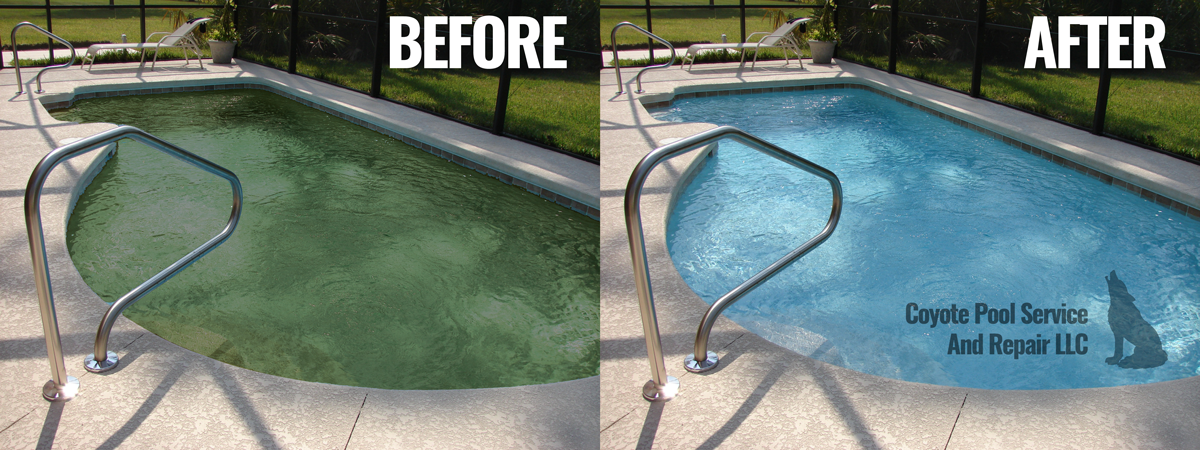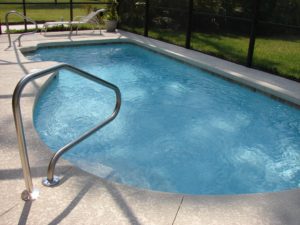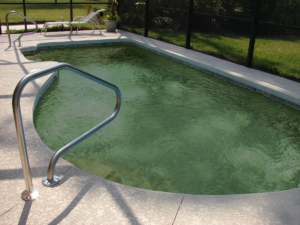
When cleaning murky and green pool water, we follow these steps:
- First and foremost, make sure you have good flow. Clean your filter and all your baskets.
- Next, balance your water. If your alkalinity is low, you are running the risk of staining your pool.
- Then, use an algaecide and shock your pool. When you purchase the algaecide ask someone that works there (or read the directions carefully). The ones that have been found to work best require you to shock with the treatment.
- After that, run your filter 24 hours and test it again. The algaecide will bring your chlorine level down so you must make sure it does not get too low. At this point, your water may be cloudy or you may have a lot of dead algae on the floor.
- Vacuum up that algae and clean that filter out. If the water is cloudy use the directions below they are great! Just keep cleaning that filter out until that water is clear.
Another effective way to solve this problem, using the cartridge filter, is this:

- To kill the algae, use lots of chlorine, algaecide etc.
- Coagulate the dead algae into large clumps. Pool supply stores sell aspray-coagulator that attaches to a garden hose. Spray it over the pool and let it sit overnight.
- Add diatomaceous earth to the filter. This white powder is sold in pool stores and used to be necessary before cartridges became affordable. Add a lot. This coats the filter and makes it impermeable, even to algae-sized particles.
- Run the vacuum and filter till pressure exceeds 35, then clean. Cleaning the filter causes a flood of the white earth to run off, so pick a good site. I bring mine to the car wash and clean it with the rinse pressure hose.
- Repeat steps 4 and 5 until the pool is clear.
Swimming Pool Cleaning Advice
This works for pool cleaning service, and you don't lose pool water, but here are a couple of points:
- 1. Prevention is best. Keep chlorine levels over 2ppm, use an algaecide, even when the pool looks good.
- 2. The cartridge filter rarely survives. Once the pool is clear, buy a new filter and throw out the old one.
- 3. Algae make swimming pool water green.
Here is more Swimming Pool Cleaning advice and input:
Your pool water turned green most likely because of algae bloom in your pool water. When you shocked the pool and added the copper algaecide you might have oxidized the copper in the algaecide. What I would do if I were you take a sample of the water (about 16oz.) to your local pool store and have them test for metals.

Another possibility is that there is metal in the water, which will react with chlorine and turn green or brown. Many parts of the country have naturally high levels of metal in their water, so this can be a problem any time replacement water is added to a pool.
Use Natural Chemistry's MetalFree or another chelating agent. Algae is probably at the bottom of your pool had the same problem the bottom of my pool was brown. I went to pool store and they told me to do the following: raise ph above 8 test ph. next 1 lb of yellow out and 1 lb of shock run filter, then brush and then vacuum. next 12 hrs later 1/2 bag of shock. Next 12 hrs later 1/2 bag shock.
Test your chemicals run filter brush and vacuum and you should be good to go my pool is above ground 4,500 gallons so talk to a pool store.
Yellow out is shock by the way always read the product labels mixing the wrong chemicals together pose health risks. Your pool water is green because your PH is out of balance making your chlorine ineffective and your filtering system is not working correctly.
Algae is certainly the cause of the green, but an imbalance of pH and/or alkalinity is why you have algae in the first place (while there is adequate chlorine). Very high or low pH significantly decreases the effectiveness of chlorine.
We suggest that you test and adjust your pH and alkalinity first (take a water sample to your local pool store and have them test it if needed).
Once those are balanced, shock the water and use an algaecide. Run the filter 24 hrs per day and vacuum the dead algae debris often - you'll also have to clean the filter almost daily. Once the green starts to disappear, add a blue clarifier to help clear the dead algae from the water and eliminate any cloudiness.
The oxidation rate of your chlorine is affected by the pH level. ppm of your chlorine is just a quantity and the oxidation rate is the quality of the water. To properly control a pool you should use a pool controller that measures the oxidation rate or ORP.
The absolute fix for algae bloomed pool cleaning: DRAIN, ACID WASH, and REFILL.
Acid Washing Cleaning an In-Ground Pool: Also called a drain & acid clean. An acid wash becomes necessary if the pool has turned into the "black lagoon". This may occur if the winterizing process is not done properly, or if the pool has been stagnant for a period of time so that algae has taken over. If you notice scaly, amphibian creatures splashing around out back, it's probably time to drain & acid clean.
Our general rule of thumb for determining the need for an acid wash is: if you can see the bottom of the pool (the floor) then you can usually bring it back with chemicals, labor, and extensive filtering.
However, once a pool has turned dark green or even black, algae and mold spores have impregnated themselves into every porous depth of the pool surface and are difficult or impossible to remove by traditional cleaning and chlorinating methods.
As a result, the pool will continue to spawn new mold, algae, and bacteria at an accelerated rate causing the pool to turn green quickly even though you may be vacuuming and chlorinating more. This will play havoc with your filter media such as sand, cartridges or DE requiring frequent media changes to remove the contaminants.
If the floor is not visible, the cost of the chemicals and labor will generally be greater than the acid wash charge and take much, much longer. Also, extensive algae blooms will permanently stain and adhere to plastered, concrete and gunite pools, making an acid wash desirable.
An acid wash is, put simply, purposeful stripping of a tiny layer of plaster or concrete, exposing fresher, undamaged and clean material beneath. Therefore, it is ill-advised to make it an annual custom, which will accelerate the need for replastering.
Most plaster coats (sometimes called whitecoat or marcite) are in excess of 1/2", so a few careful acid washes should not hurt. Pools can also be commercial strength bleach washed or high pressure washed if the affected area isn't that bad.
